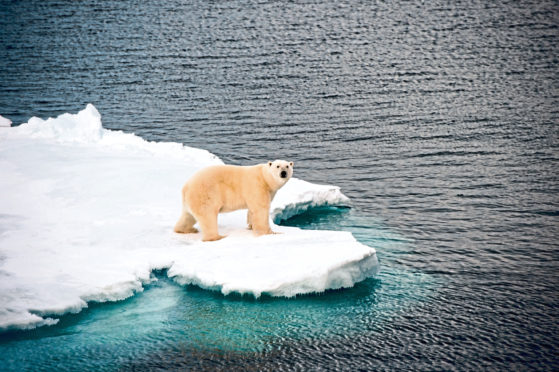
One of our planet’s last great wildernesses, the Arctic is truly a land of extremes.
Populated by creatures that have somehow worked out how to survive in its icy climate and hardy people who have worked out how to live off the land and those animals, it’s like nowhere else on Earth.
Criminally, it is now under severe threat, with global warming making the ice shrink in area and volume.
The more we pester the Arctic, the faster it will disappear.
As it melts twice as fast as the rest of our world, we can see in the Arctic what is in store for the rest of us – just as canaries warned of coal-mine dangers, the melting ice is a portent of calamity.
A stunning new book takes an expert in-depth look at what is going on, at the area’s history and future, its amazing wildlife and incredible beauty.
“When they projected the latitude of where the sun would be continuously present or absent for six months at a time, the Greeks found it went through a constellation they called Arktikos, the Great Bear,” says author Richard Sale.
“They therefore called the latitude at which this phenomenon would occur the Bear’s Circle, the Arctic Circle.”
One major feature is the permafrost, which Richard explains was once unknown to Europeans – until they tried to bury their dead.
“In Europe, the influence of the North Atlantic Drift largely prevented the creation of permafrost.
“Europeans only became aware of its existence when Arctic explorers attempted to bury their dead and encountered the unyielding, frozen ground beneath the top, thawed, layer.”
Unicorns, believe it or not, also pop up in this fascinating account of a huge, largely ignored part of our planet.
“There are references in the Bible and early writings in India that may refer to unicorns but at some stage, a real narwhal tusk must have given credence to the existence of an animal no-one had ever seen,” adds Richard.
“Consequently, when a tusk was found on the shore of the Kara Sea sometime in the 16th Century, its appearance reinforced the legend.”
The polar bear, of course, is one of the magnificent beasts that has learned how to survive in the Arctic, though it’s also facing a terrible battle to continue doing so as the planet warms up.
Richard reveals that its famous white coat benefits from a second coat of longer hairs, that can be the difference between life and death, too.
“Polar bears have guard hairs, longer and thicker hairs that add little to the insulation properties of the fur.
“The hairs of the underfur are wavy, which allows them to interlock when overlapped, trapping air, with the guard hairs protecting the integrity of the system when the animal is underwater.
“When the bear emerges from the water, the springiness of the guard hairs allows the fur to bounce back and so encourages air entrapment.”
If only mankind could look after his own planet as efficiently – as the book reveals, we have already come alarmingly close to damaging the seeds being stored to make medicines.
“On Svalbard, a Global Seed Vault was opened in 2008. Buried in a mountain, the vault is a depository for seeds from plants vital to human food supplies and medicines,” says Richard.
“Svalbard was chosen as the permafrost underlying the island was considered impregnable. In 2016-17, with local temperatures 7°C above normal, rain and melt water entered the vault.”
The reason for this mild weather is feedback mechanisms, at work in the far north and mean the Arctic is warming twice as fast as the rest of the planet.
Pollution is another danger.
“The Arctic is vulnerable to pollution from sources other than metal mining and smelting and the drilling for fossil fuels,” says Richard.
“Arctic rivers carry run-off from these industries to the Arctic Ocean.
“Pollutants also attach to snowflakes, which have a large surface area relative to rain drops, so are easily brought to the ground or ocean surface.”
The people who live in this part of the world are also under serious threat, with PCBs – polychlorinated biphenyls – a big issue.
“Because traditional food still forms a significant fraction of their diet, Inuit also show elevated PCB levels, this being particularly worrying in nursing mothers,” adds Richard.
Let’s hope mankind really decides to sit up, take note and look after Mother Nature, and places like the Arctic.
The Arctic, by Richard Sale and Per Michelsen, is published by Whittles at £25, ISBN No. 978-184995-342-9

Enjoy the convenience of having The Sunday Post delivered as a digital ePaper straight to your smartphone, tablet or computer.
Subscribe for only £5.49 a month and enjoy all the benefits of the printed paper as a digital replica.
Subscribe